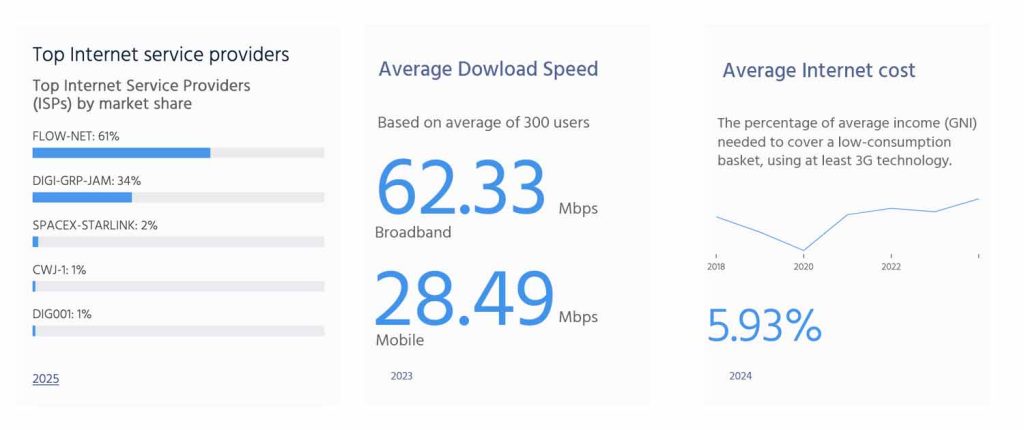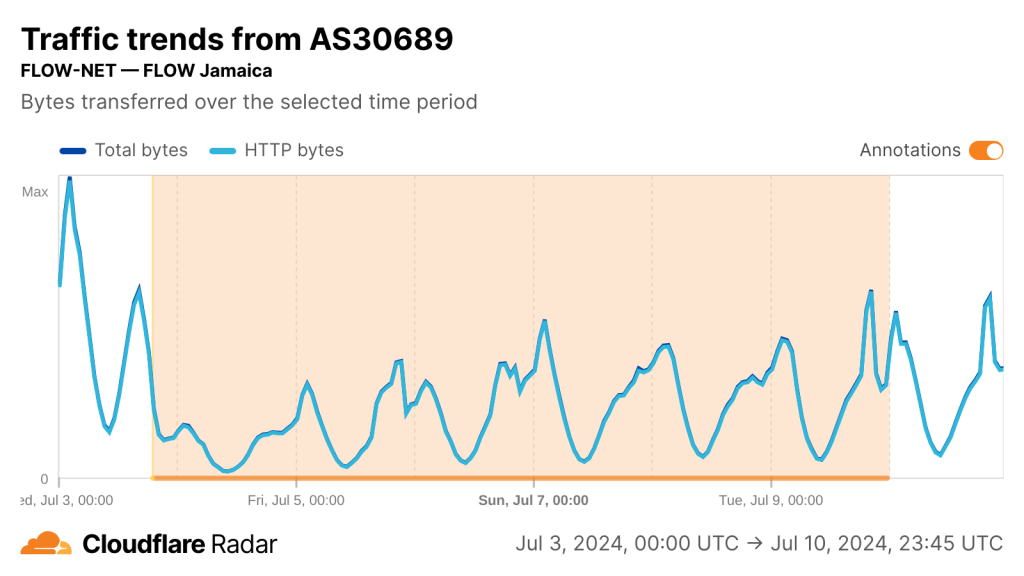- The impact of Hurricane Beryl on Jamaica’s Internet infrastructure has highlighted the need for improving resilience.
- According to the Pulse Internet Resilience Index (IRI), Jamaica’s Internet was the 10th most resilient in the Caribbean and 120th globally as of 2023.
- Internet Service Providers are looking at ways to improve their reliability in the face of growing power outages and larger tropical storms.
Jamaica’s two leading Internet Service Providers (ISPs) recently announced that they are improving the resilience of their networks to maintain connectivity for their customers during extreme weather events and power outages.
Flow, Jamaica’s largest broadband provider, is in the final phase of upgrading its copper-based telecommunication network to 100% fiber, which it claims will provide faster speeds, enhanced reliability, and environmental benefits.
“It reduces the dependence on power…bringing our consumption down by upwards of 30 percent to 35 percent,” Stephen Price, general manager of Cable and Wireless Jamaica, which trades in the consumer market as Flow Jamaica, told the Jamaica Observer.
A national broadband fiber network has become essential for all countries. It provides high-speed Internet access to homes, businesses, and schools, making basic amenities such as education, health care, and government services more affordable and efficient. The new infrastructure will also reduce Internet outages related to copper theft, which has plagued the country for more than two decades.
Mobile broadband provider Digicel also announced its plans to upgrade its infrastructure to alleviate storm and power-related outages by installing solar power packs and battery backup at 40% of its 900 cell sites. Flow has around 200 solar power sites.
According to the Pulse Internet Resilience Index (IRI), Jamaica’s Internet was the 10th most resilient in the Caribbean (see interactive) and 120th globally as of 2023.
As its Pulse Country Report shows, several areas for improvement exist, including increasing mobile and fixed broadband performance, affordability, and market competition.

Weather and Power Are Also Affecting Resilience
Flow and Digicel’s initiatives have been somewhat propelled by Hurricane Beryl, which hit several Caribbean islands in July 2024. While Jamaica did not experience a complete Internet outage during or after the storm, connectivity was significantly impacted (Figure 2), and many parts of the country—St Elizabeth, Westmoreland, Clarendon, and Manchester—were disconnected from mobile and fixed broadband services for several months.

In 2024, Cloudflare Radar recorded six national Internet outages in Caribbean countries attributed to extreme weather, three related to Hurricane Beryl.
Several guest authors have noted on the Pulse Blog that many communities worldwide are or will experience increasing Internet outages related to increased risks of extreme weather events affecting their telecommunication infrastructure.
Further reading:
- Are Subsea Cables Feeling the Heat From Climate Change?
- Understanding Cross-Layer Internet Resilience with Xaminer
- Keeping the Internet on Following Natural Disasters
Another issue compromising Internet availability in the region is power outages. Since the start of 2023, Cloudflare Radar has recorded 38 power-related Internet disruptions, eleven of which have been in the Caribbean. This does not include localized power outages, which have grown rapidly between 2021 and 2023 (see interactive).
Jamaica’s aging power infrastructure, decreasing power production (down 33% since 2000), and relatively low renewable power generation sources (see interactive) compound this issue further.
Flow and Digicel’s aforementioned efforts seek to alleviate their reliance on Jamaica’s electricity distributor (Jamaica Public Service Company). However, they and Jamaica’s Internet users still largely depend on the public utility.
While we don’t currently include data on electricity resilience in the Pulse Internet Resilience Index—due to a lack of global, up-to-date open-source data—we recognize it is one of, if not the most critical component of the Internet. If there is no electricity to power routers, switches, receivers, and data centers, then there is no Internet. As such, decision-makers must consider their resilience in any Internet resilience-related policies and projects.
Tell Your Own Data-Driven Stories With the Pulse API.
Photo via Digicel Jamaica X account.


